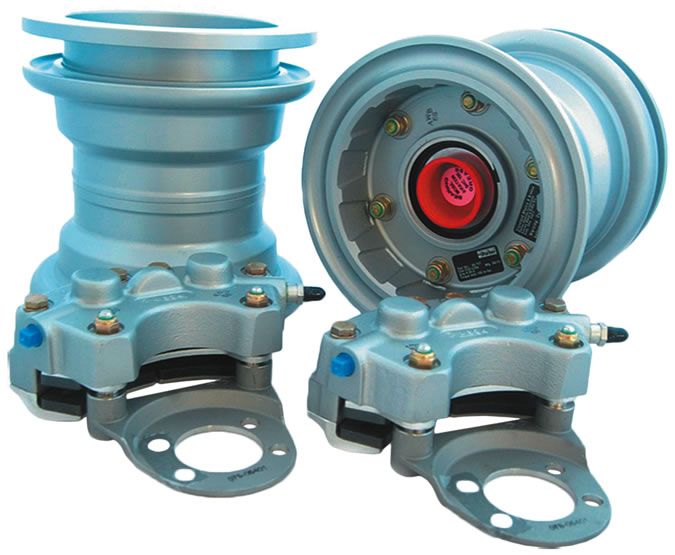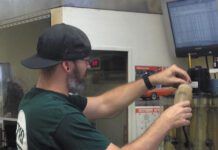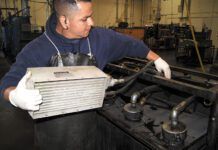We stand on them, we ride them, we ignore them-and yet, fortunately, they rarely let us down. However, as good as brakes have become, their enemies are still neglect and corrosion, which can lead to that horrible feeling of nobody’s home when you rock forward with your toes-followed shortly by the sounds of bending metal.
We’ll go through how modern general aviation aircraft disk brakes function, what you should know about their care and feeding, who makes most of them and what your options are if you’re flying an older airplane with brakes that are either not very good, or adequate-but you can’t get parts.
Brakes 101
Stopping general aviation airplanes has come a long way from the days when a pilot simply closed the throttle, pulled back hard on the stick to drive the tail skid into the turf and hoped.
Main gear wheel brakes went through numerous iterations including drums, expander tubes and, best of all, hydraulic disks. The Cleveland line of wheels and brakes became the gold standard for general aviation several decades ago. It was bought out by Parker Aerospace, which kept the Cleveland name alive, and now accounts for about 80 percent of the wheels and brakes installed on general aviation airplanes.
Life further improved for general aviation pilots when manufacturers decided that the individual wheel brakes would be actuated by pedals above the respective rudder bar rather than one-inch-square postage stamps pressed with the pilots heel. A pilots toes proved to be better able to modulate pedal pressure, not to mention simply hitting the pedal at all.
In a typical general aviation airplane-and somewhat simplified-pressing on the toe brake moves a mechanical linkage connected to the master cylinder and pushes a piston inside the master cylinder to increase pressure on the hydraulic fluid stored inside the sealed cylinder. The fluid pressure increase is transmitted through lines to the brake assembly on the landing gear wheel.
When the pilot removes pressure from the toe brake, a spring pushes the piston back to the full off position, which allows the fluid that was pushed into the brake assembly to be pulled back toward the master cylinder. A compensating mechanism in the master cylinder also helps assure that any excess fluid goes to the right place-the fluid reservoir-so that the brake doesn’t drag or, worse, lock up. While it all sounds simple in theory, getting brakes to apply linearly with force applied and then release when force is removed-and do so consistently-has driven engineers and aircraft owners to tears.
Most general aviation airplanes have single-disk brakes-heavier airplanes use multiple-disk systems. In a single-disk system, the brake works by applying friction to both sides of a rotating disk that is attached to the main landing gear wheel. The idea is to convert kinetic energy to heat.
Steel has proven to be the best all-around metal for absorbing heat for maximum braking. There is a brake lining (or pad or puck) in the caliper/brake housing, positioned on either side of the brake disk. The inboard brake lining is stationary-riveted to the back plate of the brake housing.
The caliper also contains a piston or pistons in cylinders, which are used to move the outboard brake linings. Hydraulic pressure from the brake master cylinder enters the brake cylinder and forces the piston toward the disk, pushing the brake lining on that side of the caliper against the disk. The disk is free to move laterally, so it is pressed against the inboard brake lining by the outboard brake lining, creating the friction required for braking.
When pressure on the brake pedal is removed and the spring in the master cylinder pushes the piston in the master cylinder back to the off position, hydraulic pressure against the brake piston is removed and a return spring or springs move the brake piston back to the off position so the brake doesn’t drag.
Self Adjusting
There is a self-adjusting mechanism and pin in the brake cylinder, so that as the brake linings wear, the piston travel is adjusted so that the same travel of the piston is always required to apply the brake.
Air in the brake lines will compress, which does anything from making brakes spongy and braking action unpredictable, to not work at all. A bleeder valve is installed on the brake housing so that air can be bled from the system.
Brake linings are either organic-originally asbestos, but now usually Kevlar impregnated with various metals-or metallic. Organic linings are used for lighter weight airplanes. It’s easy to tell which is which-organic linings have holes in them for the rivets that mount them on the calipers, metallic do not, and they are mounted to a metal backing plate with pins.
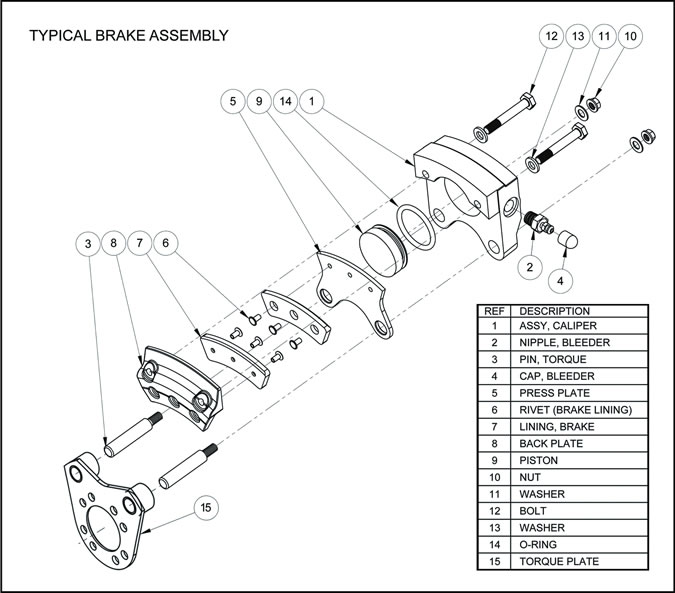
Because of concerns with corrosion of steel brake disks-corrosion pitting speeds the wear of brake linings and reduces braking effectiveness-different metals have been tried. Stainless steel is used as well, but it has only half the ability to absorb heat as steel. Its not uncommon for brake disks to be chromed to fight corrosion, but the chrome eventually wears through and the exposure returns. At least one supplier offers a nickel-plating of the disk, but it degrades brake effectiveness, so it is removed from the portion of the disk swiped by the brake linings after the plating process.
Certification
Certification of braking systems involves a calculation as to the heat energy that has to be created to stop the airplane in slightly over 10 seconds. Testing then involves putting the system designed from those calculations on a dynamometer test stand and demonstrating that the system can make the required 10- to 12-second stop 100 times (the brakes are allowed to cool after each stop), while changing brake pads no more than once.
In terms of the energy required to make a 10- to 12-second stop, Grove Aircraft owner Robbie Grove guided us through a calculator on the company’s website that showed that for a Cessna 210 touching down at a weight of 3500 pounds and starting to apply the brakes at 55 knots, each brake would have to absorb over 243,000 foot-pounds of kinetic energy.
According to Grove, nosewheel airplanes without nosewheel steering must have brakes that have 50 percent more capacity than those with nosewheel steering-although that is still lighter than a nosewheel steering mechanism.
Heat
Retained heat is the enemy of brakes-the brakes have to create heat, but they have to shed it. As the lining heats up, it loses its effectiveness. For modern disk brakes, that’s usually not a problem as even hard braking to slow to taxi speed will still allow plenty of brake effectiveness when taxiing in-unless the pilot is one of those who taxis at 1300 RPM while riding the brakes. However, heat can be a problem for nosewheel airplanes that don’t have nosewheel steering at airports where its necessary to taxi a long way when there is a crosswind.

Care and Feeding
The brake system can correct for small fluid leaks through a compensating port in the master cylinder. It will route brake fluid in from the reservoir-so long as the fluid lasts. That means that a part of the pilots preflight should be to check for leaks in the parts of the brake lines that can be seen as well as for any drips or puddles underneath the brake assemblies. Scott Utz, president of Arapahoe Aero on Denvers Centennial Airport, told us that if there is any fluid noticed, the brakes should be checked and any repairs made before the next flight. Its pretty simple: If the brake runs out of fluid, its not going to work.
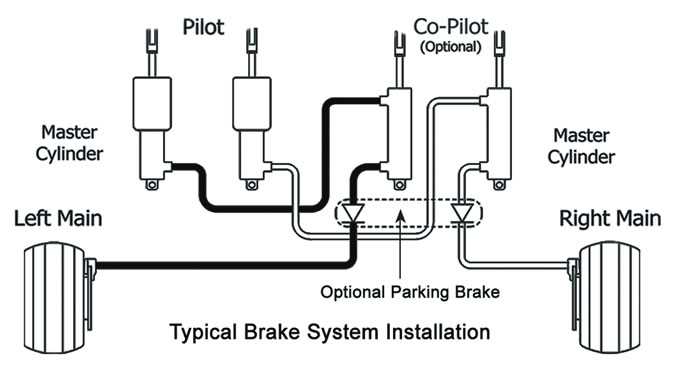
Vern Rodgers, Tech Support Manager at Parker Wheel and Brake Division (Cleveland), told us that the brake problems he sees most often come about because owners are reluctant to pay attention to their brakes-they too often wait for something serious to show up, such as a leak or complete failure. Its much cheaper to replace worn brake pads than to have to do repairs and component replacement because the pads wore out and metal-on-metal wear wrecked the disk and parts of the caliper.
Brake pads generally run $18 to $20 for an airplane the size of a Cessna 172. Two are needed per brake and replacement takes about 30 minutes a side, according to Scott Utz.
No Wear Indicators
There are no wear indicators for brake pads. Minimum thickness for brake pads is generally 0.100 inch-however, the service manual for the particular type of brake is definitive. Once the linings are worn below limits, there will be metal-to-metal contact between either the steel rivets of organic linings or the metal backing plate and pins of metallic lines and the brake disk. (Grove Aircraft brakes use brass rivets that will not damage steel brake disks.) The steel-to-steel contact will rapidly start to erode the disk. While linings are $20 each, a disk is $100 to $120 for something the size of a Cessna 172-its foolish to tear up a disk because of a delay in replacing linings.
In addition, the brake piston is designed for used with a brake pad that is within tolerances. Once the pad is worn below tolerances, the piston will extend too far, potentially leading to a brake fluid leak. Worse, its O-ring may come out of the caliper, which will result in a massive brake fluid leak and early brake failure.
Scott Utz told us that when his company gets a call to come get an airplane that has had a brake failure, almost invariably examination shows that the brake linings were gone and the piston had come so far out of the caliper that the brake fluid was lost.
Check Wear at Oil Change
Utz recommended checking the brake lining thickness at each oil change-its one of the courtesy inspections his company does for its customers. Otherwise, the brake pad thickness is only checked at the annual inspection-which he does not consider to be frequently enough. He also said that Parker produces a key fob with a quick reference tool that allows assuring that a brake lining is thicker than 0.100 inch.
Vern Rodgers of Parker/Cleveland emphasized that one of the best ways to make brakes last is to use them. As with airplanes generally, lack of use is simply not good-especially when it comes to the risk of corrosion, which will attack all metallic brake system components.
In addition, non-use allows the glaze on the brake pads to break down. When brake linings are replaced, there is a conditioning process required-which the shop should do. It involves hard stops from a fast taxi. It imparts the glaze to the linings that is important to good braking action. When the glaze breaks brake effectiveness is reduced.
There is no hard and fast rule on how long linings and disks will last, although it should be more than a few hundred hours. A great deal depends on conditions in which the airplane is operated, or not operated, and whether the pilot rides the brakes while taxiing.
Rodgers told us that brake hoses should be replaced every 10 years and other components inspected regularly for condition.
Grove also recommended replacing the O-ring any time the caliper is off of the brake, as they are inexpensive and will wear out, causing leaks and brake failure.
Upgrades
Owners of older airplanes that have mechanical disk brakes, hydraulic disk brakes, mechanical drum brakes, hydraulic drum brakes, expander tube brakes or brakes manufactured by companies such as McCauley that either no longer exist or were bought out (and the new owner quit supporting the line) have been finding it more and more difficult to get parts for their brakes. Fortunately, the situation is starting to improve as suppliers expand their product lines to provide modern disk brakes for older airplanes.
The McCauley line was purchased by Parker, but is no longer supported. Parker offers kits to convert McCauley wheels and brakes (most brake conversions require doing both the wheel and brake) to Parker/Cleveland-they start at about $2000.
Grove Aircraft makes wheels and brakes that will fit many older aircraft-it recently obtained an STC for the Super Cub series to convert them to their hydraulic disk brakes. Robbie Grove told us that the company has been very successful in working with owners and the FAA to get field approvals for many classic and antique airplanes that were built in such small numbers that obtaining an STC is not financially viable.
While field approvals are reportedly notoriously hard to get, Grove said that his company keeps an extensive file of approvals that have been received, which has helped greatly when a new FSDO is approached for an approval. In addition, the company is seeking STCs for brake conversions for many of the classic airplanes manufactured in the 1940s and 1950s.
A relatively new entrant into the field is Airframes Alaska, which offers PMA-replacement wheels and brakes, Cleveland wheels and brakes, as well as its own line of wheels and brakes. Currently, they have direct replacement parts and subassemblies for the Cessna 180, 185 and 206 series as well as Piper PA12, 14 and 18s.
We spoke with Israel Payton in customer support, who told us that Airframes Alaska will also sell individual components in circumstances where they might only be available in kits from other suppliers.
Conclusion
Modern disk brakes are effective and reliable, and should provide years of solid service-if the owner is willing to do routine preventive maintenance. That means regularly checking brake pad wear and replacing the pads before they reach the wear tolerance, as well as watching for evidence of corrosion.
Each preflight inspection should include a check for any leaks-if any are found, the brake should be inspected and repaired prior to flight. Oh, and don’t ride the brakes when taxiing.

